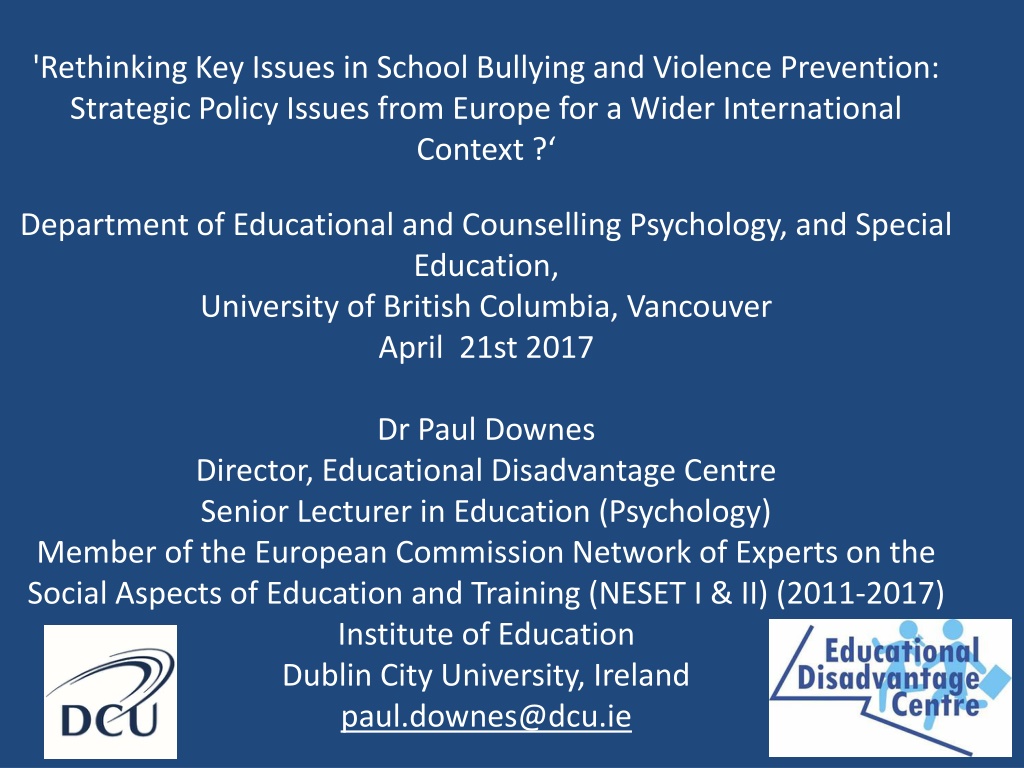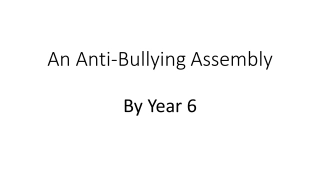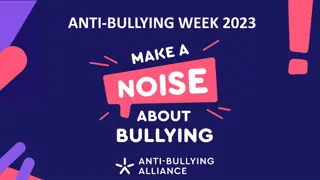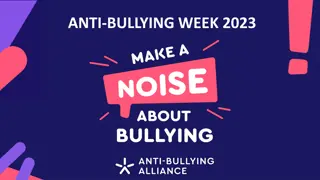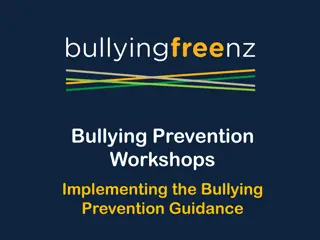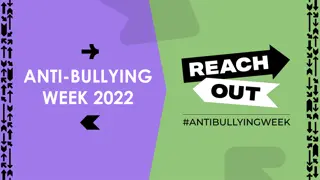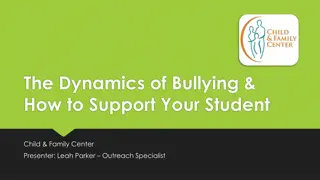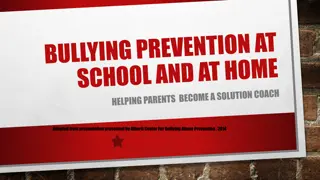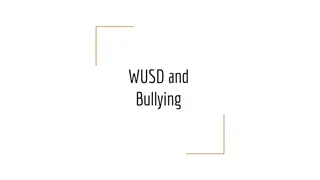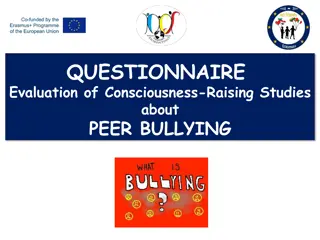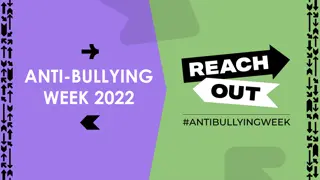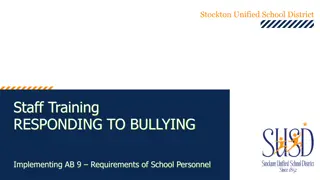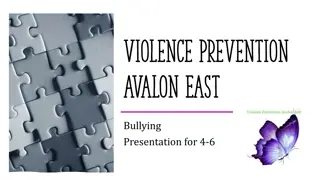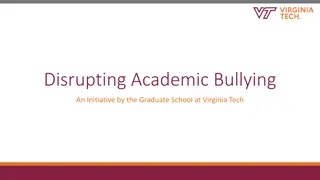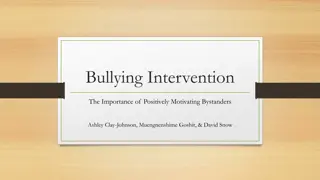Strategic Policy Issues in School Bullying and Violence Prevention
This content discusses key issues in school bullying and violence prevention, focusing on strategies and practices in Europe and internationally. Dr. Paul Downes, a senior lecturer in education, presents evidence from research on bullying, aggression, and violence in schools, along with recommendations for creating inclusive and safe school environments. The content emphasizes the importance of addressing discriminatory bullying, promoting peer defenders, and enhancing indicated prevention methods. Structural indicators are examined to identify gaps in policy across European countries.
Uploaded on Sep 19, 2024 | 0 Views
Download Presentation

Please find below an Image/Link to download the presentation.
The content on the website is provided AS IS for your information and personal use only. It may not be sold, licensed, or shared on other websites without obtaining consent from the author. Download presentation by click this link. If you encounter any issues during the download, it is possible that the publisher has removed the file from their server.
E N D
Presentation Transcript
'Rethinking Key Issues in School Bullying and Violence Prevention: Strategic Policy Issues from Europe for a Wider International Context ? Department of Educational and Counselling Psychology, and Special Education, University of British Columbia, Vancouver April 21st 2017 Dr Paul Downes Director, Educational Disadvantage Centre Senior Lecturer in Education (Psychology) Member of the European Commission Network of Experts on the Social Aspects of Education and Training (NESET I & II) (2011-2017) Institute of Education Dublin City University, Ireland paul.downes@dcu.ie
Downes, P. & Cefai, C. (2016). How to tackle bullying and prevent school violence in Europe: Evidence and practices for strategies for inclusive and safe schools. Luxembourg: Publications Office of the European Union. https://bookshop.europa.eu/en/how-to-prevent-and-tackle-bullying- and-school-violence-pbNC0415454/ Aim/Scope of Report: To inform policy-makers and practitioners at EU, national, regional and local level on strategies and practices for prevention of bullying and violence in schools across the EU. Combines European legal and policy focus with international empirical research A particular focus on bullying and violence with regard to age, ethnicity and migrants, disability, social inclusion, sexual orientations and gender.
* Examines evidence from European and international research on bullying in schools, aggression and violence, developmental psychology, and school health promotion. *Informed also by responses on current national strategies in Europe from Members of the ET 2020 School Policy Working Group coordinated by the European Commission, Directorate-General for Education and Culture, international researchers from ENSEC (European Network for Social and Emotional Competence) and a number of NGOs across EU Member States. Supplemented by : Downes, P., Nairz-Wirth, E., Rusinaite, V. (2017). Structural Indicators for Developing Inclusive Systems in and around Schools in Europe. Luxembourg: Publications Office of the European Union. https://bookshop.europa.eu/en/structural-indicators-for-inclusive- systems-in-and-around-schools-pbNC0116894/
1. Structural Indicators to Reveal Strategic Gaps in Policy in European Countries for School Bullying and Violence Prevention 2. Discriminatory Bullying - Definitional Concerns - Empirical Accounts of Discriminatory Bullying by Teachers, including Authoritarian Teaching - Differentiated Needs Selected Prevention Focus Neglected 3. Peer Defenders: - Empirical Concerns - Legal Concerns - Reductionist Understanding of Motivation and Lack of Clarity on Prevention Levels - Social Identity Concerns 4. Indicated Prevention: Speech and Language Therapists as Part of Multidisciplinary Teams
5. Limited Quality of Research Parental Involvement, Older Students Voices and Co-Construction of Resources for School Bullying and Violence Prevention 6. Common Strategic Approach for School Bullying, Violence Prevention and Early School Leaving Prevention 7. Move Towards Promotion of Inclusive Systems Not Simply Pre-packaged Programmes
Is there a national strategy for bullying prevention in schools in your country? Austria Yes Belgium (Fl) No Bulgaria Yes Cyprus No Czech Republic Yes England No Estonia No Finland No official national strategy but bullying is in the National Core Curriculum and Government Programme and national rollout of KiVa programme France Yes (as Harc lement) Greece Yes Hungary No Combined responses from: EU Commission ET2020 School Policy Working Group of Senior Education Officials from National Ministries/ENSEC/NGOs surveys.
Homophobic Bullying Directly Addressed in National Anti- Bullying Strategy Austria Belgium (Fl) Bulgaria Cyprus Czech Republic England Estonia Finland France Greece Hungary Ireland No No, but some focus in anti- discrimination law No No No No, but in individual schools No No No, not directly but it is on the Ministerial agenda No No Yes
* Homophobic bullying lacks a strategic focus in many EU Member States. According to the EU Agency for Fundamental Rights' survey, the highest levels of hostility and prejudice towards LGBTI groups recorded in the EU are in Bulgaria, Hungary, Italy, Latvia, Lithuania, Poland and Romania. * It is notable that very few of these countries address prevention of homophobic bullying in schools in a strategic manner. * The prevention of discriminatory bullying in school (against groups such as Roma, minorities, migrants, as well as against those experiencing poverty and socio-economic exclusion) needs a stronger strategic focus in many EU Member States.
2. Discriminatory bullying Blurring of power imbalance in Olweus definition of bullying - Power imbalance becomes perspectival
Beyond Authoritarian Teaching and Discriminatory Bullying Teacher discriminatory bullying of students in a sample of 1352 immigrant and Roma students as part of a wider sample of 8817 students across 10 European countries (Bulgaria, Cyprus, France, Germany, Greece, Italy, Portugal, Romania, Slovenia, Spain) (Elam 2013). Elam s(2013) 10 country European study regarding the fundamental importance of teacher influence on discriminatory bullying -Those immigrant and Roma students who think the teacher exhibits similar behaviour towards native and immigrant and Roma children in the class are those bullied least in the last 3 months. In contrast, those who declare that their teacher favours native children over immigrant/Roma students are more vulnerable to suffer some form of bullying.
Greek study (Kapari and Stavrou, 2010) of 114 secondary school students (58 female, 56 male) drawn from three Greek public middle schools. In schools with high levels of bullying, students consider their treatment by adults to be unequal, the rules to be unfair, and student participation in decision-making to be very limited.
Authoritarian Teaching WHO (2012) Modifications that appear to have merit include: establishing a caring atmosphere that promotes autonomy; providing positive feedback; not publicly humiliating students who perform poorly; Cefai & Cooper (2010), Malta review of qualitative research: the autocratic and rigid behaviour management approach adopted by many teachers in their response to misbehaviour. Their blaming and punitive approach was seen in many cases as leading to an exacerbation of the problem...It looks...that perceived victimisation by teachers was more prevalent and had more impact than victimisation and bullying by peers
Percentage of Socioeconomically Disadvantaged Students who Agree/Disagree with the Following Statements: School Belonging and Feeling Like an Outsider (PISA 2012) (OECD 2012) I feel like an outsider (or left out of things at school), % Disagree (S.E) I feel like I belong at school, % Agree (S.E) CANADA 82.9 (1.0) 72.7 (1.3) Chile 82.6 (1.6) 88.0 (1.2) Sweden 74.8 (1.9) 87.0 (1.3) United Kingdom 74.9 (1.5) 86.9 (1.1) OECD Average 78.1 (0.3) 86.2 (0.2)
Differentiated Needs Selected Prevention Focus Neglected Universal All Selected Some, Groups, Moderate Risk Indicated Individual, Intensive, Chronic Need
Many prominent international reviews (e.g. Vreeman and Carroll 2007; Durlak et al., 2011, Weare and Nind, 2011) construct the debate on prevention approaches in basically dichotomous terms regarding universal versus targeted interventions. Similarly, whole school intervention programmes such as KiVa in Finland distinguish two levels, universal and indicated (Salmivalli et al. 2011; K rn et al., 2011a; K rn et al., 2011b; Saarento et al., 2014), though Cross et al. (2012) go further than this. In a A Call for More Effective Prevention of Violence In Response to the Shooting at Sandy Hook Elementary School a Position Statement of the Interdisciplinary Group on Preventing School and Community Violence, endorsed by 183 organisations and more than 200 prevention scholars and practitioners, stated that research-based violence prevention and related comprehensive support programmes should be offered, following a threetier approach
3. Peer Defenders The position of KiVa - Salmivalli and Poskiparta (2012) that peers need to be challenged to intervene requires much further consideration and caution.
Peer Defenders: Empirical Concerns Ttofi and Farrington (2012): - highlight an evaluation comparing two UK secondary schools with a peer-support system and two without (Cowie et al., 2008), where very little difference was found between student perceptions of safety in schools with or without the peer-support system in place - older students in schools without peer support responded that they felt safer in toilets and lessons than students in schools with a peer-support system.
Referring to Canadian research (Hawkins et al., 2001), Ttofi and Farrington (2012) raise further concerns with peer defenders intervening in aggressive ways, peer interventions may reinforce the aggressive behaviour of school bullies and promote a cycle of violence . Forsberg et al. s (2014) Swedish qualitative research involved 43 semi-structured individual interviews aged 10-13 years across 5 schools. * observed that social hierarchies exist among the students, which are kept in mind when observing bullying and guide their actions by evoking and mutually interacting with self-protecting considerations (e.g. the fear of retaliation, social disapproval, social blunders, getting bullied, losing friends or losing social status).
Whereas bystanders with self-protection concerns avoid intervening when the bullies are older than they are, they see themselves as more capable of intervening if they are older than the bullies. These themes of social hierarchy and fear require further reflection, given also that issues of self-protection (Bellmore et al., 2012), including fear of consequences of intervening (Rigby and Johnson, 2005; Thornberg 2007; Thornberg, 2010; Thornberg et al., 2012) have been identified by students regarding why they did not defend a victim of bullying.
In Psaltis (2012) research sample of 3869 of the Greek student population from primary and secondary schools, for the not- involved students between primary and secondary schools there was a decrease (by half) in the actual provision of help and an increase in their wish to help, as well in their doing nothing and just watching the incident. The shadow of inactivity on the part of peers is highlighted as not being through lack of will, but other factors warranting further investigation.
A students intuition about the risks of getting involved may not need to be challenged but rather listened to. Their fear of getting involved may be a rational fear, a reading of circumstances where intervening would place them also at heightened risk of being bullied, with potentially long-term damaging consequences that are now well-documented in the international research literature.
Peer Defenders: Legal Concerns Recognition of bullying as a child welfare and child protection issue (Farrelly, 2007; 8th European Forum on the Rights of the Child, 2013) renders it problematic that responsibility may be displaced onto other children to provide support and active defending. Defenders who intervene may or may not be putting themselves at risk of being bullied, depending on the motivations and power of the child/children who are perpetrators of the bullying.
A system response to emotional supports risks being negligent, if it relies centrally on children and young people to provide these supports for situations with such serious long-term consequences. From a national policy perspective, it may also be problematic legally to place a burden of support on peers to deal with potentially highly complex emotional issues and to encourage interventions to defend the victim against the perpetrator Interventions to defend may also be placing the child or young person at risk of themselves being bullied. At least it is a reasonably foreseeable consequence that this could occur and this potentially breaches a duty of care on the State to all its students not to encourage them into situations that may be of harm for them. Medical injunction: Primum non Nocere; First, do no harm.
Ttofi and Farringtons (2012) conclusion arguably does not go far enough, at least from a legal perspective regarding promotion of peer defenders: Various authors have acknowledged the significant challenges in implementing peer support schemes. Challenges include hostile reactions towards the peer supporters by other students and school staff (Cowie, 1998) as well as poor communication and lack of commitment of the part of staff and students (Cowie et al., 2004). This is not to suggest that these schemes should be abolished. Potentially, peer support schemes may be useful as long as they are carefully implemented as in the KiVa program for example (Karna et al., 2011).
Even empirical gain in the aggregate does not justify a strategy inviting risk of danger to the individual student in intervening as a defender. Schools have a duty of care to each student as an individual. A utilitarian focus on the greatest good for the greatest number is to be rejected, as it does not encompass disproportionate impact upon the individual. Schools have a duty of care to the individual and not simply to the aggregate of children, so that even gains in the aggregate do not justify disproportionate risk to an individual defender from a perpetrator entrenched in bullying behaviour and likely to target defenders that challenge him/her.
It might be argued that once parental consent and student consent is given to engaging in a structured role of peer defender that this would be adequate. However, the issue is also one of informed consent with knowledge of the risks, and currently even such informed consent would be problematic, based on a limited understanding available on the complexity of this issue in international research.
Peer Defenders: Reductionist Understanding of Motivation and Lack of Clarity on Prevention Levels The KiVa approach assumes that the perpetrator s motivation is fundamentally to be interpreted in the behaviourist and social learning theory terms of Bandura (1989), so that the reward patterns for bullying become changed through the social context of the peers reactions: Bystanders maintain the bullying behaviour in part by assisting and reinforcing the bully, because such behaviours provide the bullies the position of power they seek after. On the other hand, if bystanders defend the victim, this turns bullying into an unsuccessful strategy for attaining and demonstrating high status. These views imply that a positive change in the bystanders behaviours will reduce the rewards gained by bullies and consequently their motivation to bully in the first place (K rn et al., 2011b).
Building on the social-cognitive theory of Bandura (1989) (Krn et al., 2011a), according to K rn et al. (2011b), the KiVa programme locates its theoretical background in the social status of aggressive children in general. It is assumed that bullies demonstrate their high status by harassing their low-status victims and that bullying is actually a strategy for gaining a powerful position in the peer group. In the KiVa programme, bullying is viewed as a group phenomenon.
Yet a diversity of motivations for bullying and aggression needs further recognition here. Even within social learning theory, the bullying may be imitative, for example as an entrenched pattern from home or the local community, thereby going beyond aggression as simple reinforcement (see Bandura et al. s 1961 well-known Bobo doll study). Even internal to a framework of social status theory, the motivational path is open to the bullying perpetrator to seek to sustain a high status through challenging threats to his/her authority such as that offered by a peer defender this challenge obviously could include attempts to bully also the peer defender.
Beyond the frameworks offered by Krn et al. (2011 a, b), issues of bullying and aggression linked with attachment issues arising from early childhood (Golding et al., 2013), sadistic aggression (Fromm, 1977) and emotional trauma may be more enduring; they may not be responsive to peer negative reinforcement and may even be hostile to peer defenders. A social reinforcement framework assumes a level of extraversion (i.e. adjustment to the external social world, Downes, 2003) and empathy that may not be a feature of at least some perpetrators of bullying.
While the KiVa explanatory framework is an important one, it is not an exhaustive explanation of the motivations of perpetrators of bullying and violence. Exceptions to this framework need to be envisaged in a strategic approach. There is a potential conflict of levels, where a chronic need, indicated prevention level of need in a bullying perpetrator is assumed to be moderate and malleable, i.e. occurring at a selected prevention level of need. The peer defender model assumes a selected prevention level of moderate resistance from the bullying perpetrator to the peer defender intervention. This may not be assumed to be the case. KiVa does not distinguish 3 levels of prevention (only universal and indicator)
Peer Defenders: Social Identity Concerns The issue of cultural complexity due to social group identity again leads to some caution about placing students in a role as defenders amidst potentially complex, fraught situations between different ethnic or religious groups, where the problem is not simply between individuals but groups expressing wider macrosystemic tensions.
Luc Claessens, Coordinator of Safe Schools, Antwerp municipality, Belgium (personal communication, 2015) observes that while they are not confronted with a structural problem on ethnic or racial violence or bullying over these subjects in schools in Antwerp , there is still the potential for individual-level problems to develop into wider ethnic, cultural ones: This does not mean that isolated cases of violence do not occur but the general feeling is that the trigger is far more often a personal issue (girl or boyfriend, money that has to be paid between the youngsters) than an ethnic, religious or racial one. Of course once an aggressive act towards a member of a group occurs this often triggers solidarity (our italics).
Though with highly successful results in a Finnish context of the KiVa whole school programme, the Finnish example takes place in a highly homogenous ethnic and religious cultural context. This again raises questions about its transferability to interventions in schools with students from disparate ethnic and religious backgrounds, including where discriminatory bullying may be taking place. The individualist assumption underpinning such bullying problems needs to be challenged not simply by recourse to a group context of fellow classmates in school but also wider macrosystemic factors which point to the bullying as not simply being a conflict between individuals in a group, but as expressing wider cultural conflicts.
Selected prevention levels are not simply groups of individuals. They centrally involve groups with strongly defined social identity and categorisation, such as ethnic and sexual minorities. The bullying process may be part of a wider conflict between groups based on their social identities and may not simply be a personal individual interpersonal dynamic; broadening focus to peer bystanders is only one step within a wider lens to interrogate group relations.
Salmivalli et al. have broadened the focus from children as individuals to children in a group and designed a strategy of peer defenders for children in a group. However, children of a group are not equivalent to children in a group. A peer-defenders strategy designed for children in a group may struggle to encompass conflict between children of different groups (ethnic, religious etc.). The documented fear of some children to be placed in the firing line of the bully through being challenged or encouraged to adopt a defender s approach needs to be acknowledged as a rational response to perception of threat rather than a moral failure to engage.
4. Indicated Prevention: Speech and Language Therapists as Part of Multidisciplinary Teams The need for speech and language therapists to be linked with schools, as part of multidisciplinary teams to engage in targeted intervention for language development, emerges from international research regarding language impairment as a risk factor for engagement in disruptive behaviour. Eigsti and Cicchetti (2004) found that preschool aged children who had experienced maltreatment prior to age 2 exhibited language delays in vocabulary and language complexity. The mothers of these maltreated children directed fewer utterances to their children and produced a smaller number of overall utterances compared to mothers of non-maltreated children, with a significant association between maternal utterances and child language variables.
Rates of language impairment reach 24 % to 65 % in samples of children identified as exhibiting disruptive behaviours (Benasich et al., 1993), and 59 % to 80 % of preschool- and school-age children identified as exhibiting disruptive behaviours also exhibit language delays (Beitchman et al., 1996; Brinton and Fujiki, 1993; Stevenson et al., 1985). A study of children with communication disorders found that children with language impairments, who were more widely accepted, seemed to be protected from the risk of being bullied (Savage, 2005).
The particular lack of speech and language therapists (SLTs) in European schools as part of multidisciplinary teams, highlighted in the Eurydice report (2014) on early school leaving, is of real concern here for students at the chronic need, indicated prevention level, where maternal language difficulties may be affecting their violent behaviour The level of maternal language difficulty does not have to be at a clinical level of difficulty for it to centrally contribute to a range of school-related problems, potentially including aggression and bullying, as well as hindering social relationships and sense of belonging to school.
Limited Quality of Research Parental Involvement and Co- Construction of Resources for School Bullying and Violence Prevention Axford, Farrington et al. (2015) observe two primary means of involving parents in school-based programmes to reduce bullying: (i) providing information to parents in various formats such as newsletters or booklets, and (ii) holding parent-teacher meetings (Farrington and Ttofi, 2009). Little integration of bullying research literature with family support focus for families at indicated prevention level with chronic needs
5. Limited Quality of Research Older Students Voices and Co- Construction of Resources for School Bullying and Violence Prevention Yeager et al. (2015) raise a concern about the limitations of intervention strategies for older adolescents that rely on adult authority or that imply that they lack basic social or emotional skills. Secondary school students may resist being literally programmed into particular modes of behaviour and thought. A shift in conceptualisation is needed to make these students subjects of policy rather than simply objects of policy and programmes. In a US context, Yeager et al. (2015) question state mandates regarding anti-bullying programmes for high schools though not for middle schools. They recognise the need for new interventions to be developed and shown to be effective for older adolescents.
A notable aspect of their conclusion is that it is not sufficient to age up existing materials that are tested with younger children, e.g. by switching out the examples or the graphic art used in the activities. The UN Convention on the Rights of the Child may be less influential in US school and research contexts, given that it is not ratified by the US, unlike all EU countries. This would invite consultation with young people in the design of materials for anti-bullying, building on Art. 12, with increasing input from older students. Avoiding intervention for older students would be a legal abdication of responsibility.
It is of concern that international research on bullying interventions noticeably tends not to locate such approaches against the backdrop of international legal standards, for example, regarding non-discrimination or the right to the highest attainable standard of physical and mental health. A specific community outreach strategy, which offers opportunities for intercultural contacts is an important approach for overcoming prejudice between groups. * This can be facilitated by shared communal spaces, which bring different groups together, such as community lifelong learning centres, arts and sports facilities, libraries, green spaces, community afterschool centres, family resource centres, religious centres, gyms.
Common Strategic Approach for School Bullying, Violence Prevention and Early School Leaving Prevention through common system responses for inclusive systems. Quiroga, Janosz and Bissett (2013) 493 high-risk French-speaking adolescents living in Montreal *depression symptoms at the beginning of secondary school are related to higher dropout mainly by being associated with pessimistic views about the likelihood to reach desired school outcomes; student negative self-beliefs are in turn related to lower self-reported academic performance and predict a higher risk of dropping out. Quiroga et al. (2013) interventions that target student mental health and negative self-perceptions are likely to improve dropout prevention .
Common system supports needed for bullying and early school leaving prevention (Downes & Cefai 2016) School Climate, Teasing, Bullying In a sample of 276 high schools, Cornell et al. (2013) found that risk of early school leaving increases if a student experiences an atmosphere of teasing and bullying even if s/he is not personally bullied. Cornell et al. (2013) Notably, the increased dropout count that was associated with Prevalence of Teasing and Bullying was quite similar to the increases that were associated with FRPM [i.e., poverty] and academic failure .
6. Common system supports needed for bullying and early school leaving prevention (Downes & Cefai 2016) A striking commonality of interests with regard to strategic approaches for bullying prevention in schools and early school leaving prevention: Direct and indirect effects of bullying on early school leaving relevant to perpetrators, victims (school absence, negative interpersonal relations with peers and conflict with teachers, low concentration in school, decreased academic performance, lower school belonging, satisfaction, and pedagogical well-being, with the effects of bullying exacerbated for those already at risk of early school leaving, negative school climate influences).
Common systems of supports (transition focus from primary to post-primary, multiprofessional teams for complex needs, language support needs, family support services and education of parents regarding their approaches to communication and supportive discipline with their children, outreach to families to provide supports, addressing academic difficulties). Common issues requiring an integrated strategic response, including the prevention of displacement effects of a problem from one domain to another, such as in suspension/expulsion which may make a bullying problem become an early school leaving problem. Common causal antecedents (negative school climate, behavioural difficulties, trauma)
Teacher professional development and pre-service preparation focusing on developing teachers relational competences for a promoting a positive school and classroom climate, including a focus on teachers conflict resolution and diversity awareness competences Early warning systems.
7. Move Towards Promotion of Inclusive Systems Not Simply Pre-packaged Programmes - - Systemic Understanding of Background Conditions Structural Indicators
Cultural Cognitive Bias: Individual Foreground Perception Neglects Background System Conditions Masuda and Nisbett (2001) presented realistic animated scenes of fish and other underwater objects to Japanese and Americans and asked them to report what they had seen. *The first statement by American participants usually referred to the focal fish ( there was what looked like a trout swimming to the right ) whereas the first statement by Japanese participants usually referred to background elements ( there was a lake or pond ). *Japanese participants made about 70 percent more statements about background aspects of the environment. Foreground Child/Intervention as Cause Background system School/System Background Conditions
